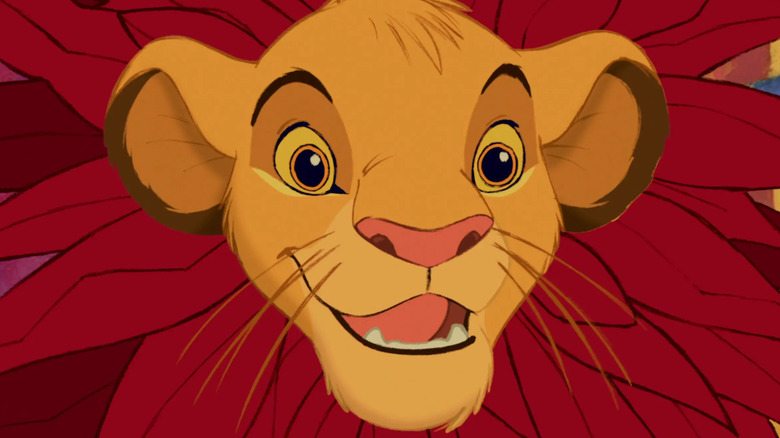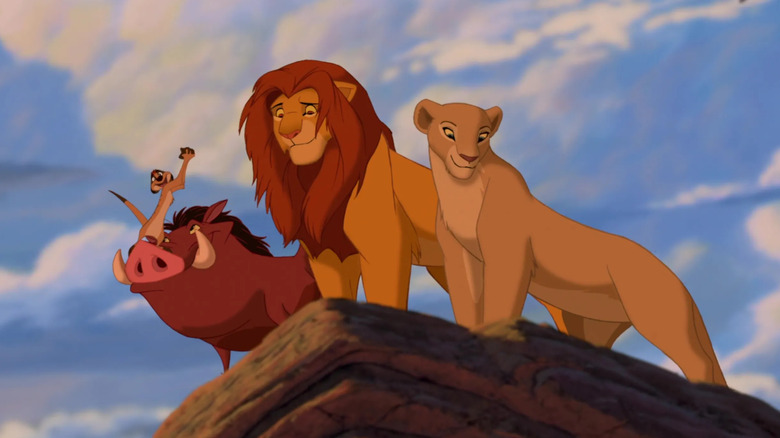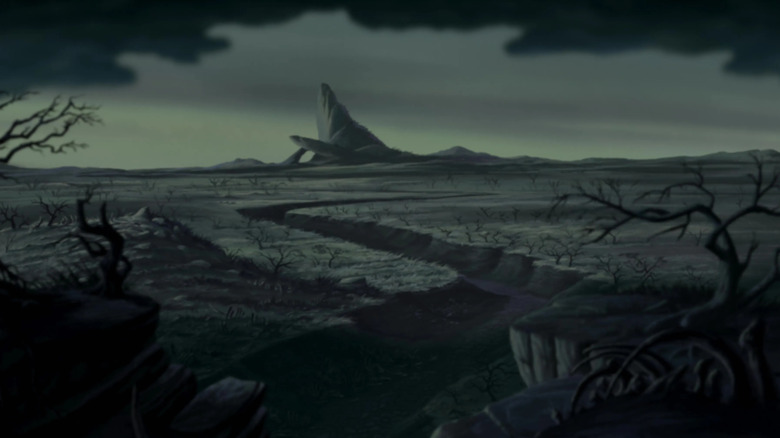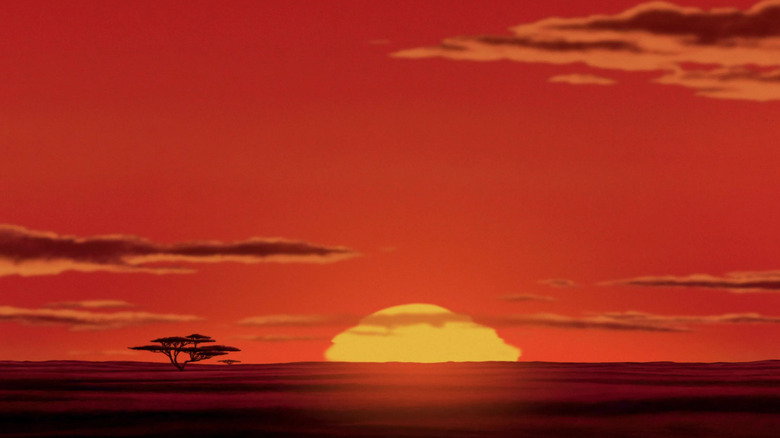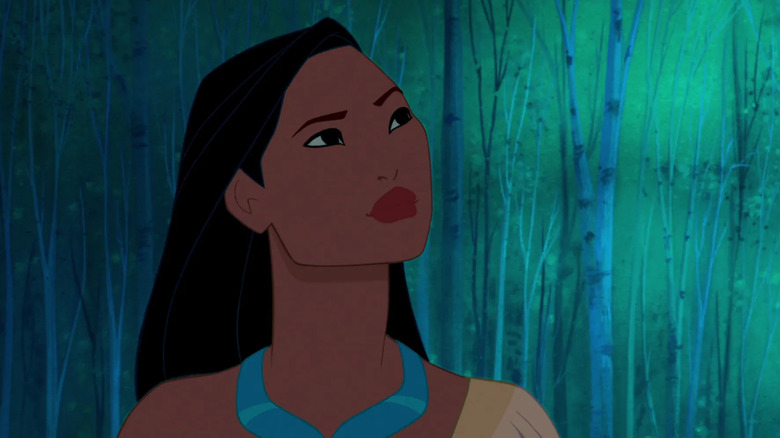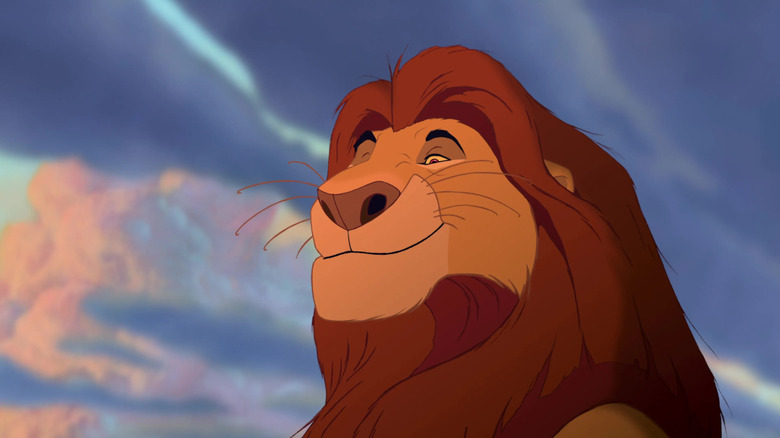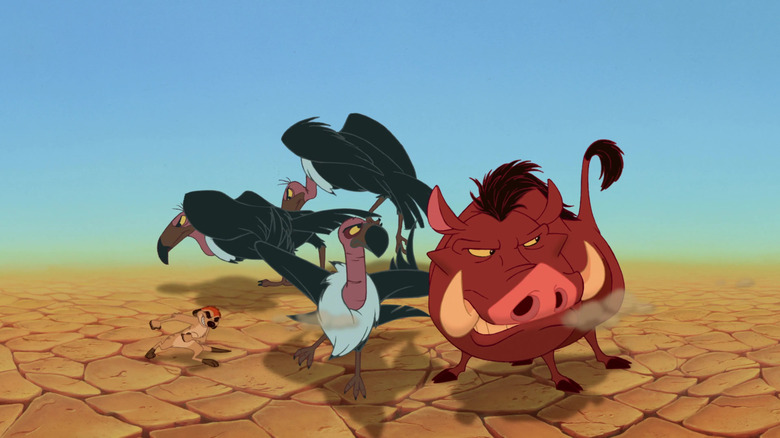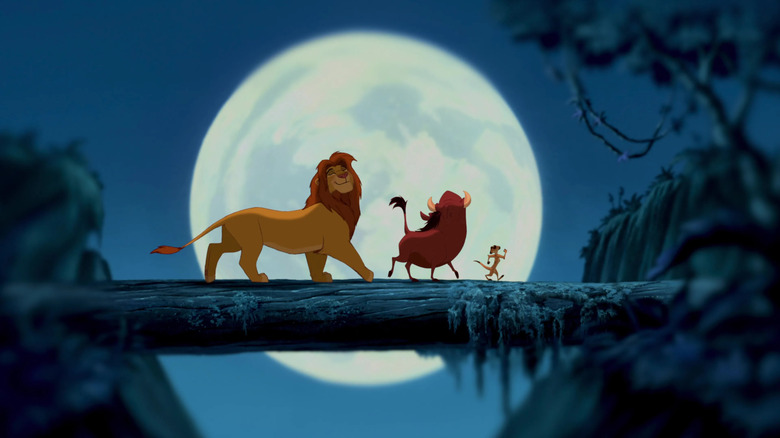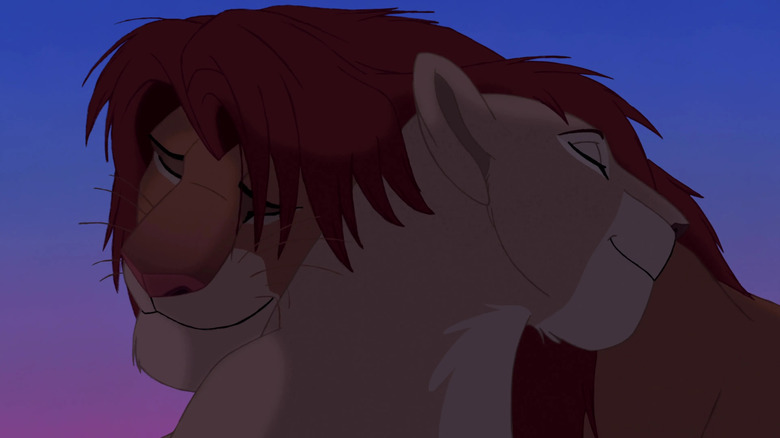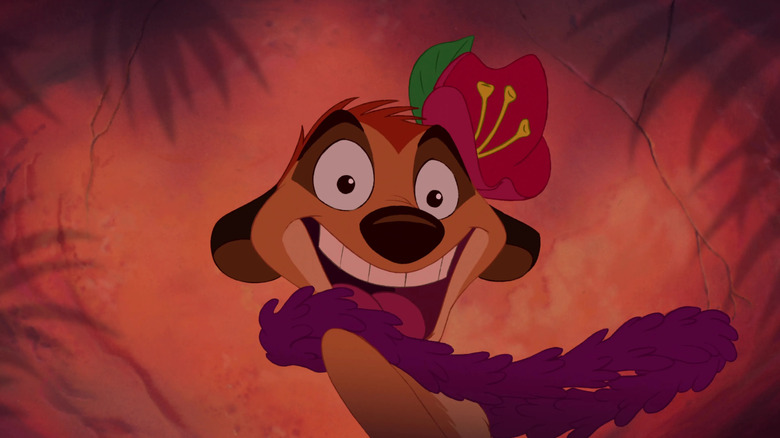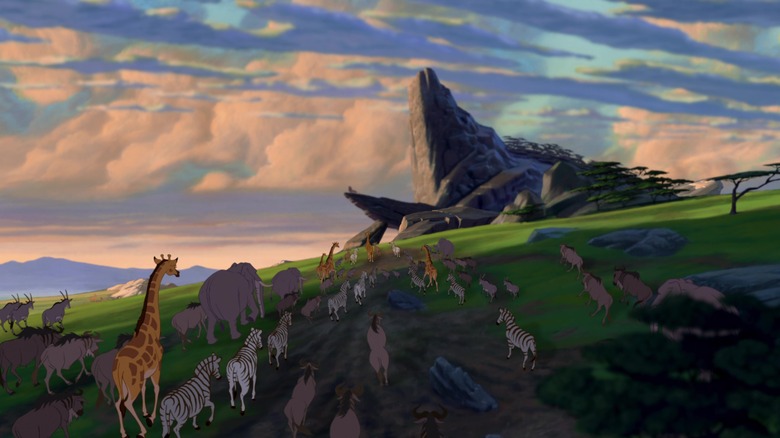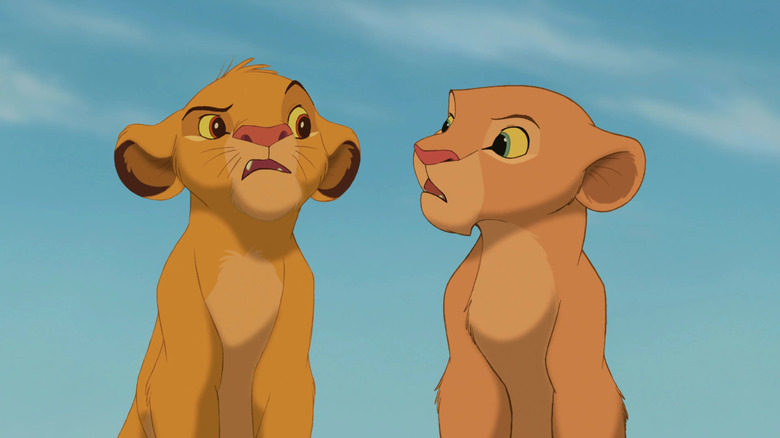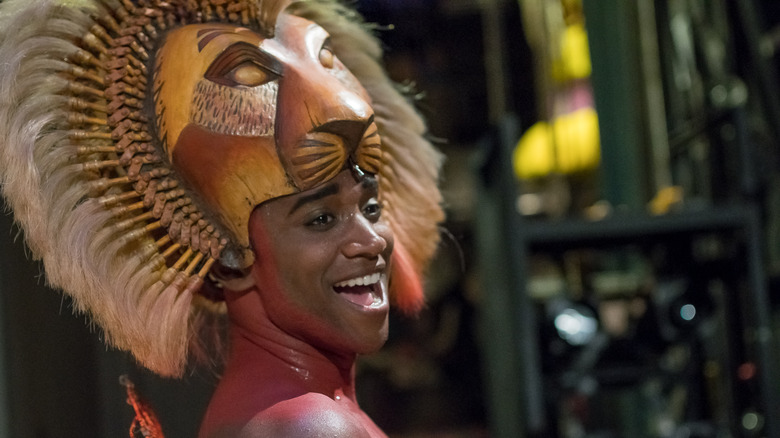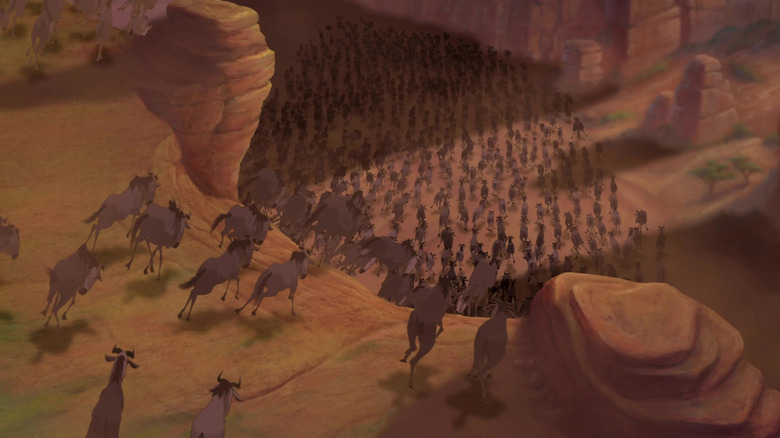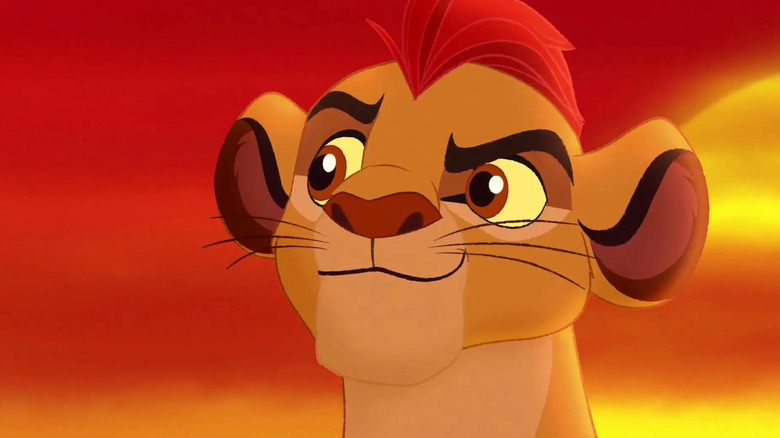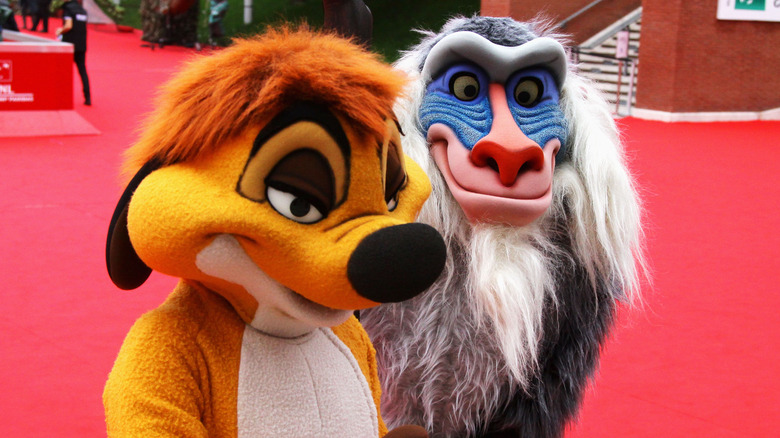The Untold Truth Of The Lion King (1994)
You'd be hard-pressed to find an animated film as influential as "The Lion King." The story remains a champion in every medium it steps its paws into: the 1994 film is the highest-grossing hand-drawn animated movie of all time, its 2019 remake is the highest-grossing computer-animated film ever, and its stage musical is the highest-grossing show in Broadway's history.
The story, characters, and themes of "The Lion King" continuously connect with audiences, and that connection goes beyond commercial success. There is something deeply profound within this tale of singing lions, gluttonous warthogs, and where we all fit within the circle of life. From the breathtaking artistry of its African setting to the multilayered lyrics of its award-winning songs, "The Lion King" reaches beyond the confines of any screen, touching audiences deeply with its resonate portrait of generational legacy.
Believe it or not, making the 1994 movie was an underdog story for the team at Walt Disney Animation Studios, one littered with doubt and obstacles to overcome. So, journey with us beyond everything the light touches, as we explore that shadowy place beyond the Pride Lands' borders. It is time... to discover the untold truth of "The Lion King."
The Lion King was Disney's first original story... kind of
Unlike every Disney animated film that preceded it, "The Lion King" wasn't inspired by any existing fairy tale or published story. As filmmakers set out to create something new, though, they found themselves weaving in allegories from classic storytelling, both intentionally and accidentally.
This is elaborated upon in the "Story Journey" bonus feature on the film's 2003 Platinum Edition DVD. Co-writer Irene Mecci shares that early in the film's development, "The Lion King" was described as "'Bambi' in Africa with 'Hamlet' thrown in." The film inherently shares a resemblance to Disney's 1942 feature "Bambi" in depicting a sweeping, nature-based artistic portfolio with a young animal protagonist coming of age after losing a parent. Director Roger Allers shares that the film's similarities to Shakespeare's "Hamlet" were unintentional at first, but once they were identified, the crew played around with how much to lean into that spirit of betrayal and redemption within a royal family. Allers says Scar was initially going to quote the line "Good night, sweet prince" before killing Mufasa, but admits that felt a little too on-the-nose.
In the same set of interviews, producer Don Hahn points out filmmakers discovered reflections of Old Testament passages within their work. Hahn cites Simba being banished from royalty and returning to a kingdom that doesn't recognize him as similar to the story of Joseph, while Simba finding wisdom from Mufasa's ghost mirrors Moses doing the same with the burning bush.
The movie was originally much darker
With a wildebeest stampede killing the hero's father onscreen, "The Lion King" is certainly one of Disney Animation's heavier films, grappling with complex themes such as mortality and loss. In spite of this, earlier versions of the movie were even darker. Executive producer Thomas Schumacher shares in Michael Goldman's book "The Art and Making of The Lion King" that the movie initially "was, in a sense, a National Geographic special that would be animated. The story was a conflict between lions and baboons." Director Rob Minkoff affirms the original treatment was "more 'True-Life Adventure' than mythical epic." It also wasn't a musical.
At the time, competing directorial visions created tension, as explained in the documentary "The Lion King: A Memoir." George Scribner and Roger Allers were assigned to direct the project together. Scribner, who had previously directed "Oliver & Company" for Disney, preferred a darker approach. Allers, who had most recently led the story department of "Beauty and the Beast," pictured something closer to the version of "The Lion King" we know today. For most decisions, they compromised to make diluted versions of their preferences, landing somewhere in the middle. Ultimately, Scribner amicably departed and Rob Minkoff, an established Disney animator, joined Allers as a new director.
ABBA turned down writing the songs
The movie's road from non-musical to undisputed musical phenomenon is explored in "Pride of The Lion King," a 2011 documentary. Lyricist Tim Rice had written songs for 1992's "Aladdin" and was invited to do the same for "The Lion King." Considering songwriting collaborators, his first inclination was none other than "Dancing Queen" superstars, ABBA. When the group declined, Rice's next idea was Elton John, but he recalls that he never thought John would say yes. Much to his surprise, the rocketman himself thought a Disney movie was a perfect opportunity for a creative challenge.
While "The Lion King" may have been different from how he and John were accustomed to making their art, Rice concedes that the songwriting strategy remained the same. "I think whether you're writing for an Argentine dictator's wife or for a warthog with wind problems, it's the same approach lyrically," Rice says in the documentary. "I just had to make sure that the words the character says are plausible, A, for the character, and B, for the story."
Hans Zimmer wrote the film's score and invited his friend Lebo M. to infuse the soundtrack with African influences, which began with the iconic chant at the very beginning of the film. "Because it wasn't going to be the expected fairytale," Zimmer explains, "the audience sits down and I was gonna let them know, 'You're not in Kansas anymore. This is gonna be different.'"
Most animators wanted to work on Pocahontas instead of The Lion King
Disney released "The Lion King" in 1994 and "Pocahontas" in 1995. The production of both movies had a bit of a rivalry, as shared in the "Pride of The Lion King" documentary. Disney animators were offered the opportunity to choose which movie they wanted to work on, and "Pocahontas" was the clear favorite between the two. On paper, the logic adds up. "Pocahontas" was a familiar story to audiences, it had a signature Disney romance at the center of it, and featured music from Disney veteran Alan Menken.
"The Lion King" director Rob Minkoff reflects, "Pretty much everybody at the studio decided that they didn't want to work on 'Lion King.' Everybody decided that they'd rather work on 'Pocahontas.'" Minkoff says he and his fellow director Roger Allers had to "beg and scrape" animators to work on their film.
Producer Don Hahn thinks the result was a unique pool of talent that wouldn't have assembled otherwise. "What we ended up with was this kind of really passionate group of guys and girls who thought there was something to this story that you couldn't get out of other movies," Hahn says. "The people we ended up getting on 'Lion King' were either getting an opportunity for the first time to lead a character or do something they hadn't done before, or were nuts about drawing animals."
Disney considered another famous actor for Mufasa
"Remember who you are." It's hard to imagine anyone else's saying those iconic words than James Earl Jones, who delivered a powerful performance as Mufasa that was so irreplaceable, Disney asked him to reprise it in the 2019 remake, the only actor from the 1994 film extended that honor. And yet, the studio initially targeted someone else to voice Simba's father.
According to the fall 2003 "Lion King" issue of Disney Adventures Magazine, filmmakers first thought Mufasa could be played by Sean Connery. Yes, James Bond himself was in the running to be the ruler of the Pride Lands. "The directors were looking for someone with strength and a sense of command in his voice, yet someone who could be a fun dad," producer Don Hahn explained to Disney Adventures, "but the idea sort of faded after we heard James Earl Jones. He was so perfect for the part."
Perfect is the only word that adequately describes Jones' performance. The actor, who also, of course, is the voice of Darth Vader (and CNN), had a lot of admirability for the animation process. In a 1994 behind-the-scenes television special, Jones said, "I think doing voice for animation is probably acting's purest, most ancient forms. It's like the Greek form of acting, ancient Greek, when they had masks on. In our case, the masks are the animators' drawings."
Vulture characters got cut for being too funny
After Simba runs away from the Pride Lands, he passes out from exhaustion in the middle of a dry plain. Vultures surround him, inspecting his body and likely hoping he's dead, just before Timon and Pumbaa run to Simba's rescue. In the film's audio commentary, producer Don Hahn shares that the vultures were originally characters with actual lines and their scene was much more than a quick appearance.
The vultures speculated about Simba's demise with dialogue that employed black humor a little too effectively. The characters were so funny that Hahn says they "stole the thunder" of Timon and Pumbaa, major characters who would stick around in the movie much longer than the vultures. The decision was made to remove the vultures' dialogue and simply show them briefly as a group rather than give them individual personalities.
As expected, Timon and Pumbaa became audience favorites, but their voice actors auditioned for different characters. Canterbury Classics' "Lion King" volume by Bill Scolon and Barbara Montini shares that Nathan Lane and Ernie Sabella, who voice Timon and Pumbaa, respectively, initially auditioned to be hyenas. Filmmakers didn't think they fit for those characters, but realized they'd be ideal as the film's wise-cracking meerkat and warthog.
Your favorite songs evolved throughout the creative process
Canterbury Classics' "Lion King" volume by Bill Scolon and Barbara Montini notes that at the same point in the story where "Hakuna Matata" would eventually reside, Elton John and Tim Rice wrote a tune called "Warthog Rhapsody." It essentially communicated the same idea as "Hakuna Matata" in describing Timon and Pumbaa's relaxed, carefree lifestyle.
Though it was ultimately removed from the film, "Warthog Rhapsody" went on to have a unique shelf life. The song was recorded by Nathan Lane and Ernie Sabella, and included on the 1995 album "Rhythm of the Pride Lands." Then nearly a decade later, Vulture shares that the creative team making 2004's direct-to-DVD film "The Lion King 1 ½" invited Rice to write new lyrics to John's melody of "Warthog Rhapsody" that could be used as a song for Timon, "That's All I Need," in the new movie.
In an audio commentary track for "The Lion King," producer Don Hahn shares that "Be Prepared," the movie's big villain song, originally came after Mufasa's death. Though its melody was the same as the song we know today, its lyrics were completely different. Titled "Thanks To Me," it had Scar singing all the ways the Pride Lands were better "thanks to" his new reign. Filmmakers later realized it made more sense to have Scar sing a song about what he was planning to do before it happened, rather than commenting on his plan after it had been put into motion.
Can You Feel The Love Tonight shocked Elton John
The Oscar-winning "Can You Feel The Love Tonight" became one of the highlights of "The Lion King," but only because Elton John addressed a creative crisis. In a 2003 DVD bonus feature, John shares, "I wrote it to be sung by the two lion cubs who were in love with each other." Upon watching an early version of the movie in a test screening, John was not pleased. "I was horrified when I heard it sung by the warthog! Oh, God. It was a shock." Yes, the entire song was performed by Timon and Pumbaa, tongue-in-cheek, while audiences watched Simba and Nala fall in love.
Director Roger Allers empathizes with John in "The Lion King: A Memoir," a 2011 documentary. "To his credit, I think, and this is really touching, I remember at the time, he said he'd always been a Disney fan," Rogers shares. "In all the Disney movies, he always loved the love songs. This is why he agreed to do it, so that he could have the chance to write an iconic love song for a Disney movie. It was like, it was all coming from the right places." Ultimately, filmmakers honored Sir Elton's wishes. While Timon and Pumbaa still sing the intro and outro of the song in the finished movie, the majority of the tune is performed by offscreen, non-character voices.
An executive wanted Timon to sing the Bee Gees
One of the funniest moments in "The Lion King" comes when Simba needs Timon and Pumbaa to stage a diversion so he can sneak past the hyenas. Timon jokingly inquires, "What do you want me to do? Dress in drag and do the hula?" A slam cut transitions into the next scene, where Timon is doing just that, while singing a quick refrain about Pumbaa set to the tune of "Hawaiian War Chant."
In the "Pride of The Lion King" documentary, directors Minkoff and Allers reveal an awkward moment that occurred when they pitched this scene. Walt Disney Studios chairman Jeffrey Katzenberg thought it was funny, but suggested it could be even better if Timon instead sang "Stayin' Alive" by the Bee Gees. Rather than a quick gag, it could be a more fleshed-out musical moment. Minkoff and Allers distinctly disagreed with Katzenberg. Not having time to change the scene before a test screening, thankfully the advance audience loved the scene as it was, so the directors earned a mandate to keep it the same. It's worth noting that in the 2019 remake, Timon again distracts the hyenas with song, but this time it's with the opening notes of "Be Our Guest" from "Beauty and the Beast."
The trailer took a bold risk
The first trailer for "The Lion King" needed to tell audiences loud and clear that this movie wasn't a typical Disney animated movie. The first impression of the film should communicate the artistry of the animators, the power of its African influences, and the dynamic nature of its soundtrack. Could a traditional sizzle reel trailer achieve such a feat? Maybe, but the crew shares in the film's audio commentary that they decided to go for a different angle instead. Rather than a usual trailer featuring action-packed clips, funny one-liners, and an epic voice announcer, the original trailer for "The Lion King" was simply the "Circle of Life" opening sequence, in its entirety and unedited.
The sequence was preceded by the film's signature deep red text on a black screen, reading: "Next summer, Walt Disney Pictures will present its newest animated feature. What follows is the opening song that begins the story." No voiceover, no music, just text on a screen ... followed by the now-iconic moment of sunrise over the savannah, accompanied by Lebo M.'s unmistakable voice. Audiences witnessed "Circle of Life" for the very first time, and "The Lion King" began its reign.
The movie was partly made from home
While the COVID-19 pandemic normalized working from home for those in post-production and animation, recent favorites like "Raya and the Last Dragon" and "Encanto" weren't the first Disney movies to be made partially from home. "Lion King" producer Don Hahn reflects in the documentary "The Lion King: A Memoir" that a different sort of disaster disrupted production — and inadvertently put the film's production well ahead of its industry.
On January 17, 1994, roughly five months before the film's debut, the Northridge earthquake shook southern California and caused severe damage. With a magnitude of 6.7, it was California's largest earthquake since 1906. Unable to travel to the studio due to damaged roads, animators resumed working on "The Lion King" from their own homes. Upon the studio's reopening, some of them changed "work from home" to "live at work," setting up temporary residence there, having no power or water at home.
The Broadway musical had unexpected origins
Vocalist/songwriter/choir arranger Lebo M. and song arranger Mark Mancina had invaluable influence in making the soundtrack for "The Lion King" one of the most commercially successful and spiritually powerful in Disney's history. Director Roger Allers praises the two artists in the "Stage Journey" bonus feature on the film's 2003 DVD. "There was so much positive energy that was still in them from the project," Allers says, "that they went on and did that other album, 'Rhythm of the Pride Lands.'"
"Pride Lands" dropped in 1995, infusing moments from the movie's score and extending them into their own songs; other times, they introduced new melodies entirely. When "The Lion King" was being considered for development as a Broadway musical, "Rhythm of the Pride Lands" was partially what convinced the play's director, Julie Taymor, to join the project, "probably more than just having seen the film," Mancina says in "The Art and Making of The Lion King" by Michael Goldman.
The album then served as a foundation from which the rest of the show stemmed, with many of its compositions featured prominently in the Broadway soundtrack. One of those was "He Lives In You," which not only made the leap to Broadway, but also served as the opening number of "The Lion King 2: Simba's Pride." Allers continues, "The Broadway show wouldn't exist without them having done that album. It's interesting how one thing grows out of the other."
There was major skepticism for the Broadway show
Despite the fact that Disney had achieved success opening its first Broadway musical, "Beauty and the Beast," there was hesitance when conversations began about doing the same for "The Lion King." Many were skeptical of its realization on stage, including members of the animated movie's crew. "I just didn't know how they could do it, except having those kind of mascots you'd see at professional NFL games walking around doing numbers," confides Elton John in the "Stage Journey" bonus feature of the film's 2003 DVD. John laughs and adds that his first reaction was a sarcastic remark, "Hey, that's gonna be really great."
The Broadway show's director, Julie Taymor, who would ultimately win multiple Tony awards for her leadership on the musical, looked past the skepticism to see the potential of how the story could be adapted for the stage in an unconventional way. In the documentary "Pride of The Lion King," Taymor elaborates on her decision to be part of the project.
"Just looking at the stampede would be the one image that would entice me to want to do it in the theater, because it was a big challenge," Taymor says. "The idea of having to put a wildebeest stampede on the stage? Yes! I'd love to try that." Haters gonna hate, and they were ultimately proven wrong. "The Lion King" made its Broadway debut in 1997 and still performs to this day.
Simba... has a son?
Those whose childhoods aligned with the 1994 debut of "The Lion King" may remember the popular direct-to-video follow-up, 1998's "The Lion King 2: Simba's Pride." In that sequel, Simba and Nala have a daughter, Kiara, whose training to become queen is the focus of the story. If your familiarization with the franchise ended in the '90s, you may be surprised to learn Simba and Nala also have a son, Kion, the main character of "The Lion Guard," a Disney Junior series that premiered in 2015.
This knowledge immediately prompts follow-up questions for anyone who grew up on "The Lion King 2," which never showed Kiara having a younger brother. A quick deep dive into the show's history yields that "The Lion Guard" actually goes to great lengths to finesse itself into the narrative of "The Lion King 2," even to the point of having guest appearances by Kovu, Zira, Vitani, and Nuka, main characters from the sequel. While the retconned presence of an additional cub offscreen for the length of "The Lion King 2" is a still a bit of a stretch, it's probably best not to hold a Disney Junior "Lion King" timeline to the standards of a Marvel or Star Wars canon, like audiences have been trained to do as of late. After all, the wacky "Timon & Pumbaa" animated show in the '90s certainly didn't adhere to any world-building master plan.
Ever wanted to visit Pride Rock? You (kind of) can
As one of Disney's biggest hits, "The Lion King" has naturally extended into various theme park and resort experiences. Right out the gate, Disney was ready.
The same summer that the movie debuted in theaters in 1994, vacationers on both American coasts could enjoy productions inspired by "The Lion King." At Magic Kingdom in Florida, "Legend of The Lion King" debuted as a live show utilizing puppets and screens to tell the movie's story. At Disneyland in California, "The Lion King Celebration" romped through the park's streets with larger-than-life depictions of jungle animals. Upon the parade's closure, the floats were sent to Florida and recycled into the Broadway-esque show "Festival of The Lion King," which debuted at Disney's Animal Kingdom in 1998 and still performs today.
Those looking to fully immerse themselves in all things "Lion King" might want to consider an overnight stay at Disney's Art of Animation Resort, which opened at Walt Disney World in Florida in 2012. As one of four animated films celebrated at the hotel, "The Lion King" area of the campus has suites whose furniture and decor are themed to the movie. Outside, giant fiberglass sculptures of characters like Mufasa and Scar welcome guests, as well as some of the most recognizable settings and scenes from the film: Pride Rock, the elephant graveyard, and even Simba, Timon, and Pumbaa walking across the log, just like in the "Hakuna Matata" sequence.
